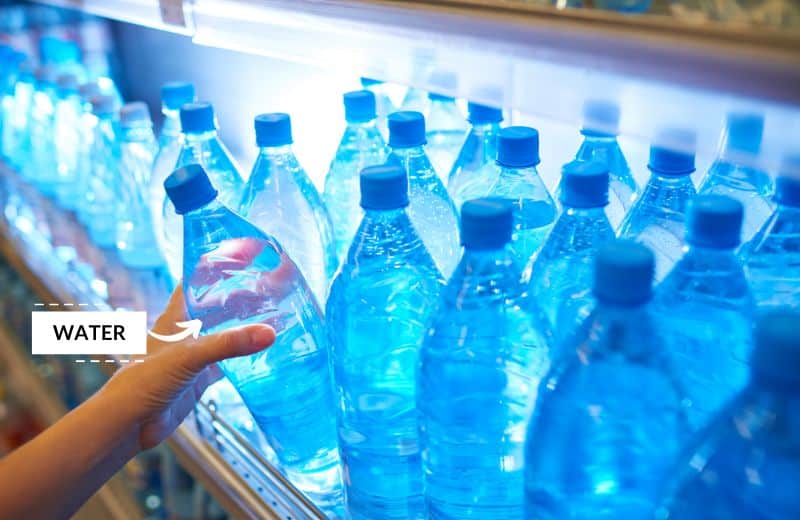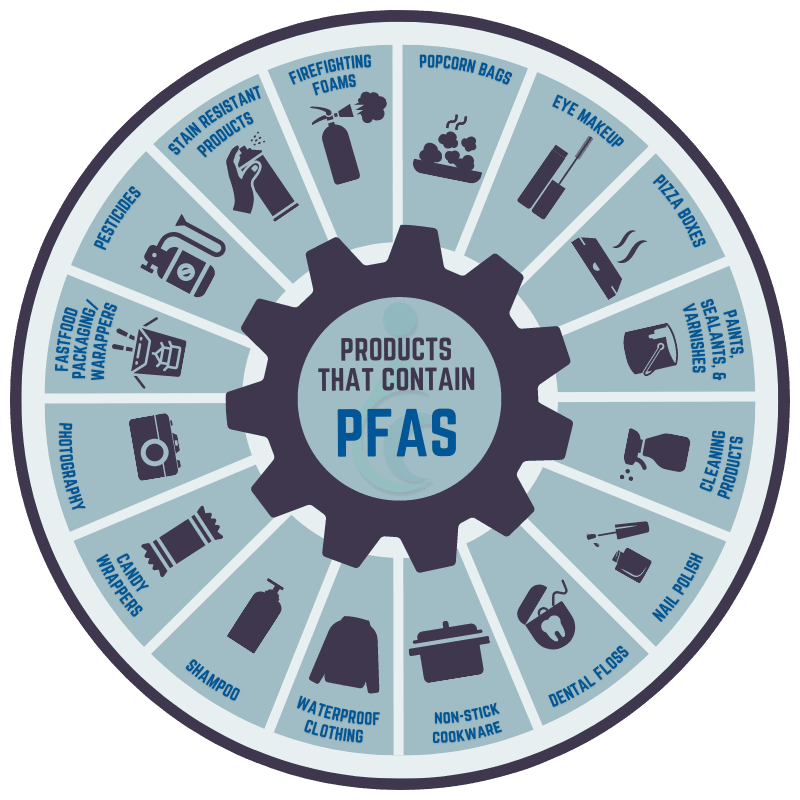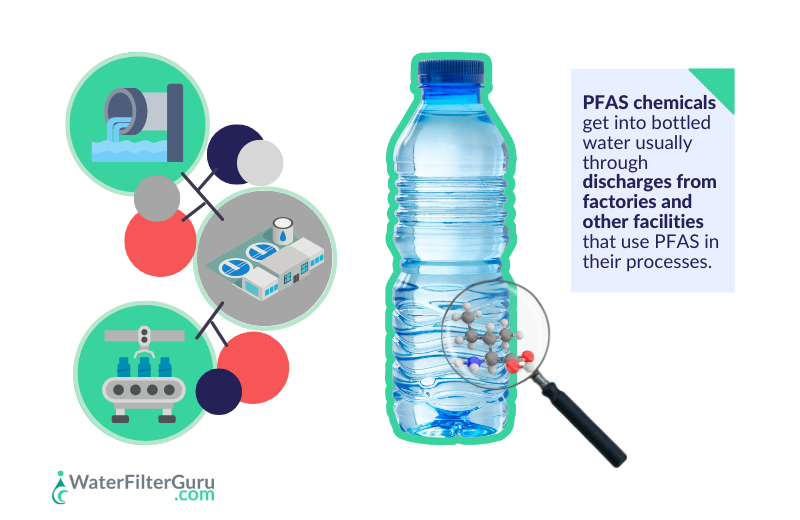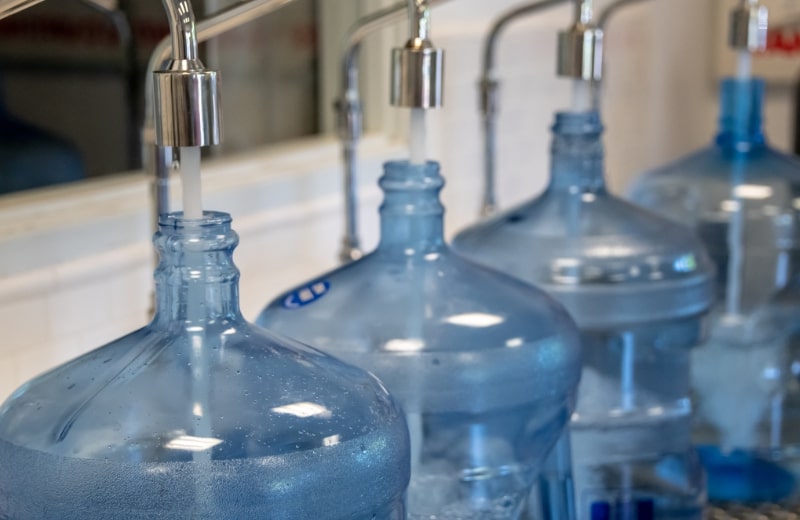Up until recently, our knowledge of PFAS, or “forever chemicals”, and their widespread contamination in the environment was somewhat limited.
But in recent years, numerous studies have highlighted the dangers of PFAS in our surroundings, including in household items, personal care products, foods, and drinking water.
In this guide, we’ve shared everything you need to know about PFAS in bottled water, including how it gets there, its potential health effects, and how you can limit your PFAS exposure from bottled water.
📌 Key Takeaways:
- PFAS are a group of contaminants that have been used widely in manufacturing processes for decades.
- The EPA currently classes PFAS as “emerging contaminants”, and there is no legal limit for PFAS in public drinking water or bottled water products.
- PFAS may have a range of effects on the human body, including cancer, developmental delays, and other serious health conditions.
Table of Contents
🔎 The Discovery Of PFAS In Bottled Water
We’ve all heard rumors and read reports to suggest that certain bottled water products contain potentially dangerous substances, from BPA to microplastics.
But the discussion around PFAS, or per-and polyfluoroalkyl substances, in bottled water has been fairly hushed – until recently.
A study of PFAS in bottled water, led by Johns Hopkins University researchers and published in the journal Water Research, made big news in 2021 and was reported by various outlets, including Consumer Reports.
The study unearthed concerning findings on the presence of PFAS chemicals in bottled water products, noting that 39 out of more than 100 bottled waters contained PFAS, and some bottled waters contained these toxic chemicals at levels that experts deemed “concerning”.
While the bottled water companies weren’t named and shamed in the study, researchers did give an indication of the types of water that were more likely to contain PFAS chemicals. Bottled spring water contained more PFAS overall than bottled waters that had been treated with reverse osmosis or distillation.
So, the risk of drinking PFAS in bottled water is real. What are the potential health effects of these chemicals, and how can you avoid them in your bottled water? Read on to find out.

🤔 What Are PFAS?
PFAS stands for per- and polyfluoroalkyl substances, which is a group of more than 5,000 chemical compounds that have been widely used in manufacturing processes and have been linked to health effects including cancer and developmental delays.
They’re often referred to as “forever chemicals” because their bonds are very strong, meaning that they don’t break down easily and linger in the environment for decades – sometimes even centuries.
This factor is what makes PFAS particularly dangerous to use in manufacturing, and yet they’re still widely used today.
Some of the current uses of PFAS are:
- In non-stick cookware
- To make waterproof textiles
- In grease-resistant food packaging
- For carpets, furnishings, and upholstery with anti-stain properties
- In firefighting foam
👨🔧 Learn more in this guide to the consumer products that contain PFAS substances.

📉 Is PFAS In Bottled Water Regulated?
Currently, there is no legal regulation for PFAS in bottled water despite its known threat to public health.
That means bottled water companies don’t have to monitor the PFAS levels in their products or reduce the PFAS present – even if high levels of potentially toxic PFAS chemicals are detected.
The Food and Drug Administration (FDA) is responsible for regulating bottled water products. As of yet, according to Consumer Reports, the FDA hasn’t set limits on PFAS in bottled water, and delayed setting these limits once again in 2020 due to data obtained from limited and outdated testing methods. This came after the International Bottled Water Association wrote a letter in 2019 that urged the FDA to set limits for PFAS.
Organizations like the Environmental Working Group (EWG) believe that PFAS levels should be strictly monitored and managed in all water sources. The EWG has proposed a Health Advisory of 1 PPT (part per trillion) for the sum of all PFAS in water, which is much higher than the EPA’s Health Advisory Level (see note below).
Note: The Environmental Protection Agency, or EPA, doesn’t regulate bottled water – it only regulates public tap water supplies. The EPA Health Advisory Level for PFAS in water is 70 PPT, but the EPA also doesn’t legally regulate these chemicals as of yet.
🚰 How Do PFAS Get Into Bottled Water?
PFAS chemicals get into bottled water when they’re given a route to enter the natural water supply that’s used for the bottled water product – usually through discharges from factories and other facilities that use PFAS in their processes.
There are two common bottled water supplies: public tap water and “naturally filtered” water from underground springs.
PFAS are widespread in the surface water supplies that are used for public tap water, and due to the lack of regulation for these contaminants, they’re not usually removed by water treatment plants.
An EWG report estimated that 110 million people could have at least 2.5 PPT of PFAS chemicals in their water. So, if you drink bottled tap water that hasn’t been purified with a process like reverse osmosis, it likely contains PFAS.
You might assume that, in comparison, the “naturally filtered” bottled spring water would contain significantly less PFAS due to being sourced from underground.
However, the Water Research report we mentioned earlier highlighted that bottled spring water actually contained more PFAS than purified bottled public drinking water. This tells us that, worryingly, PFAS contamination isn’t limited to surface water sources.
Continue Reading: PFAs in sparkling water

🩺 Potential Health Effects Of PFAS In Bottled Water
Consuming PFAS contaminated drinking water, whether that’s bottled water or public drinking water supplies, is thought to have a range of human health effects, including:
- High cholesterol
- Hormone disruption
- Developmental problems in children
- Increased risk of thyroid disease
- Changes in liver enzymes
- Reduced chances of pregnancy in women
- Low infant birth weights
- Increased risk of various cancers
Most of these health effects have been detected in studies of animals and humans exposed to two commonly-used PFAS chemicals: perfluorooctanesulfonic acid (PFOS) and perfluorooctanoic acid (PFOA).
These chemicals still show up in people’s blood, even though they’re no longer used or produced in the US. The good news is that they’re on the decline, according to a CDC report, but there are thousands of other PFAS that we’re still being exposed to today.
👨⚕️ How To Avoid Drinking PFAS In Bottled Water
Here are some of the best ways to avoid drinking PFAS in bottled water.
Read The Label Carefully
There’s no guarantee that a bottled water company will disclose if their product contains PFAS on the label, but it’s worth checking anyway.
If you can’t find specific water quality information on the label, try checking the manufacturer’s website. There might be a dedicated page that discusses the ingredients and impurities in the water, or the manufacturer might have answered a question about PFAS contamination in an FAQ page.
Contact The Manufacturer
If you don’t know whether you can believe the information on the label or you just want to learn more about the impurities in your favorite bottled water, contact the manufacturer and ask for a detailed test report for their source water.
This is especially worth doing if your preferred water product isn’t purified or filtered before being bottled.
Choose Bottled RO or Distilled Water
We mentioned earlier that the 2021 study into PFAS in bottled water noted that RO water and distilled water products – i.e. purified bottled water – were less likely to contain PFAS.
So, if you’re in a rush and just need to grab a bottle of water on the go, opt for a bottle of water that has been purified by one of these processes, rather than naturally-filtered spring water.

Filter Your Water At Home
Or, you could choose to ditch bottled water altogether and use a capable water filtration system to remove PFAS (and other contaminants) from your drinking water at home.
Good water filters for removing PFAS are:
- Activated carbon filters
- Reverse osmosis systems
- Ion exchange systems
You can install a filter along your water line, meaning that the water leaving your faucets is filtered and contains much lower concentrations of PFAS chemicals.
Related Posts:
- Can Distilled Water Get Rid of PFAS, PFOA, PFOS Contaminants?
- Reverse Osmosis Water Filters: Can They Remove PFAS?
- Find Your Perfect Bottled Water in 2024: Our List of the Best Brands
📑 Final Word
If only we had a scanner that detected PFAS substances in bottled water, so we could know for certain whether the water was safe before buying it.
However, since technology hasn’t come that far yet, you can only do what you can to limit your exposure to toxic PFAS chemicals until the EPA and FDA start taking this group of contaminants seriously.
👨🔧 If in doubt, buy RO-treated water, or cut out bottled water entirely and filter your own water at home with one of the best PFAS water filters.

